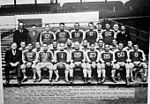Harlem River
Geographic coordinate listsHarlem RiverLists of coordinatesStraits of Bronx County, New YorkStraits of New York County, New York ... and 2 more
Transportation in New York (state)Use mdy dates from August 2019

The Harlem River is an 8-mile (13 km) tidal strait in New York, United States, flowing between the Hudson River and the East River and separating the island of Manhattan from the Bronx on the New York mainland. The northern stretch, also called the Spuyten Duyvil ("spewing devil") Creek, has been significantly altered for navigation purposes. Originally it curved around the north of Marble Hill, but in 1895 the Harlem River Ship Canal was dug between Manhattan and Marble Hill, and in 1914 the original course was filled in.
Excerpt from the Wikipedia article Harlem River (License: CC BY-SA 3.0, Authors, Images).Harlem River
Harlem River Drive, New York Manhattan
Geographical coordinates (GPS) Address Nearby Places Show on map
Geographical coordinates (GPS)
| Latitude | Longitude |
|---|---|
| N 40.834722222222 ° | E -73.934125 ° |
Address
Harlem River Drive
Harlem River Drive
10035 New York, Manhattan
New York, United States
Open on Google Maps





